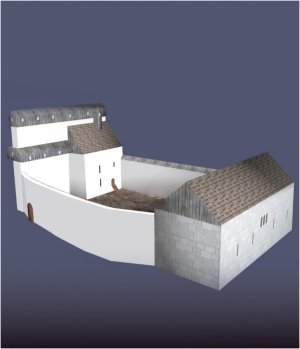|
MALI GRAD. High Medieval Castle in Kamnik
Contents

Mali grad.
Picture: Edisa Lozić.
- Acknowledgements
- 1. Introduction
- 1.1. Kamnik and its two castles
- 1.2. The history of research
- 2. Written sources
- 2.1. The first prologue: Bavarian model of positioning castles into the environment
- 2.2. Prologue No. 2: The Andechs
- 2.3. The origin and evolution of Carniola
- 2.4. Andechs' estates with ministerials in Carniola
- 2.5. Mali grad
- 2.6. Discussion
- 3. Historical pictorial representations
- 4. Archaeological findings
- 4.1. Methodology
- 4.2. Structures
- 5. Metal objects
- 5.1. Kitchen utensils, tinder, knives and razor
- 5.2. Keys, locks and bolt
- 5.3. Tools and nails
- 5.4. Horse equipment and rider's fittings
- 5.5. Belt buckles
- 5.6. Weaponry
- 5.7. Dress Accessories
- 5.8. Coins
- 5.9. Other finds
- 6. Pottery
- 6.1. Manufacturing technology
- 6.2. Pots
- 6.3. Bowls and ceramic flat vess el for baking
- 6.4. Bow-handle jugs
- 6.5. Lids
- 6.6. Tableware
- 6.7. Stove tiles
- 6.8. Earthenware lamps
- 7. Animal bones and bone fragments
- 8. Interpretation of archaeological sources
- 8.1 Prehistoric and Roman period phase 2
- 8.2. Early Medieval phase 3
- 8.3. High Medieval phase 4a
- 8.4. High Medieval phase 4b
- 8.5. Late Medieval phase 4c
- 8.6. Post-medieval phase 5
- 8.7. The material culture of the 13th century nobility
- 9. Life on the Mali Grad Hill: a Discussion
- 9.1. Mali grad within the landscape
- 9.2. Stein (12th century)
- 9.3. Medieval capital Kamnik (13th century)
- 9.4. Halved castle (14th and 15th century)
- 9.5. Fort (16th century)
- 9.6. Mali grad and the definition of the castle
- 10. Bibliography
- 11. Catalogue
- 12. Tables
- 13. Appendices
***
2009, (Opera Instituti Archaeologici Sloveniae, 15), 256 pages, b-w drawings, photos, tables, graphs and maps, 25 tabels, 20 x 29 cm, hardcover, ISBN 978-961-254-111-8.
Opera 15 | Top
|
 Institute of Archaeology
Institute of Archaeology